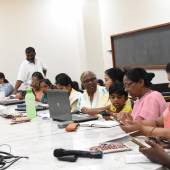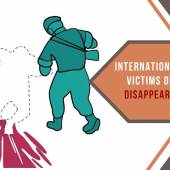Call for the Elimination of Female Genital Mutilation Practice

The International Day of Zero Tolerance to Female Genital Mutilation is on February 6
The United Nations designated February 6, 2012, as International Day of Zero Tolerance for Female Genital Mutilation (FGM). The day's objective is to encourage governments, civil society, and stakeholders to take concrete actions and raise awareness about FGM.
FGM has been practiced in some cultures for thousands of years. Despite its cultural and societal roots, the practice has harmed girls and women. To eradicate this practice, The UN stresses the need to educate, empower, and promote justice for girls and women's rights, among other community-based activities.
The Concept, Consequences, and Figures of Female Genital Mutilation
FGM, or simply "the cut," is the practice of removing all or part of the external female genitalia. It is frequently used as a component of a rite of passage, preparing young girls for womanhood and marriage.
FGM has been practiced in parts of Africa for centuries and some countries in the Middle East and Asia, though its origins are unknown.
According to the World Health Organization (WHO), FGM "comprises all procedures that involve altering or injuring the female genitalia for non-medical reasons and is recognized internationally as a violation of the human rights, health, and integrity of girls and women."
This practice has had both immediate and long-term consequences. Because it is performed in primitive and unsanitary conditions, FGM may cause severe pain, bleeding, shock, and swelling in the short term.
It results in chronic pelvic infections, urinary tract infections, and birth complications for mothers and children in the long term. The event's horror—including being physically restrained against their will—has a long-lasting effect on many women.
The World Health Organization (WHO) distinguishes four different types of FGM.
Type 1 involves removing the clitoral glans (the visible part of the clitoris, a sensitive region of the female genitals) and the prepuce/clitoral hood (the fold of skin surrounding the clitoral glans).
Type 2 is to partially or entirely remove the clitoral glans and labia minora (vulva's inner folds), with or without the vulva's labia majora.
Type 3: A covering seal narrows the vaginal opening, also known as infibulation. The labia minora or Majora are sliced and repositioned, occasionally stitched, with or without the clitoral prepuce/clitoral hood, and glans removed.
Type 4: non-medical pricking, piercing, incising, scraping, and cauterizing the female genital area.
Studies have shown that FGM has no proven health benefits and harms girls and women in numerous ways. While all forms of FGM increase the risk of health complications, the risk is higher with more severe conditions.
Despite significant efforts to eradicate the practice, certain countries have continued to practice it. According to the WHO, at least 200 million girls and women have undergone FGM at some point in their lives.
If current trends continue, 15 million more girls aged 15–19 will be exposed by 2030.
In 2021, 4.16 million girls worldwide faced FCM. FGM affects 44 million girls under the age of 14 worldwide, with the highest prevalence in the Gambia, Mauritania, and Indonesia, where around half of the girls aged 11 and younger have been cut.
FGM is still performed to gain social acceptance and avoid community condemnation. It has been practically ubiquitous and uncontested in some societies. In certain cultures, FGM is unquestioned.
Preconceived views about acceptable sexual behavior often drive FGM. It is often seen as a necessary part of a girl's upbringing, preparing her for adulthood and marriage. It ensures premarital purity and marital fidelity.
A Call to Action for the Elimination of Female Genital Mutilation
As we are confronted with FGM, a critical question is: what can we do individually and collectively to prevent and eradicate this practice?
The fight against FGM has relied heavily on international cooperation. Innumerable organizations and rulings around the world have denounced the practice. Legislative frameworks have been modified, and political support for ending FGM grows.
In most countries, the practice of FGM is on the decline, and a growing number of women and men are speaking out against it on social media.
In 2007, UNFPA and UNICEF initiated a joint program on FGM to speed up the practice.
And in 2008, WHO, together with nine other UN partners, stated the elimination of FGM to support increased advocacy to stop the practice of FGM.
In 2018, WHO launched a clinical handbook on FGM to improve healthcare providers' knowledge, attitudes, and skills in preventing and managing complications of FGM.
UN Secretary-General Antonio Guterres has reminded the world to combat and end this practice together, as he says: Together, we can eliminate female genital mutilation by 2030. Doing so will positively affect girls' and women's health, education, and economic advancement.
While acknowledging the cultural and social beliefs behind the practice, FGM has become a severe form of discrimination against girls and women. This practice reflects deep-seated gender equality.
Not only have their rights to health and safety been neglected, but also their physical integrity has been violated, as has their right to be free from torture and inhuman or degrading treatment.
Therefore, efforts must be coordinated and systematic, involving whole communities and focusing on human rights and gender equality.
These efforts should emphasize societal dialogue and community empowerment to end the practice.
The Catholic Church has condemned the practice of FGM. Pope Francis calls this practice a degradation that has to be combated.
At a meeting on women's issues hosted by the Vatican's Council for Culture in 2015, Pope Francis said: The many forms of slavery, the commercialization, and mutilation of the bodies of women call out to us to be committed to defeating these types of degradation that reduce them to mere objects that are bought and sold.
Because the practice has existed in many countries and has affected many people, we must unite our efforts to combat and eliminate FGM.
Besides the organization's efforts as indicated above, individuals' efforts are counted in campaigning to end FGM practice.
What do you think about this practice? Have you ever encountered such a practice in your community or culture? In your opinion, what should be done to end this pandemic of FGM?
Be part of the online conversation and participate on social media. Tell the world how you're # Acting2EndFGM!
We would appreciate it if you shared your views in the commentary box.
Radio Veritas Asia (RVA), a media platform of the Catholic Church, aims to share Christ. RVA started in 1969 as a continental Catholic radio station to serve Asian countries in their respective local language, thus earning the tag “the Voice of Asian Christianity.” Responding to the emerging context, RVA embraced media platforms to connect with the global Asian audience via its 21 language websites and various social media platforms.














